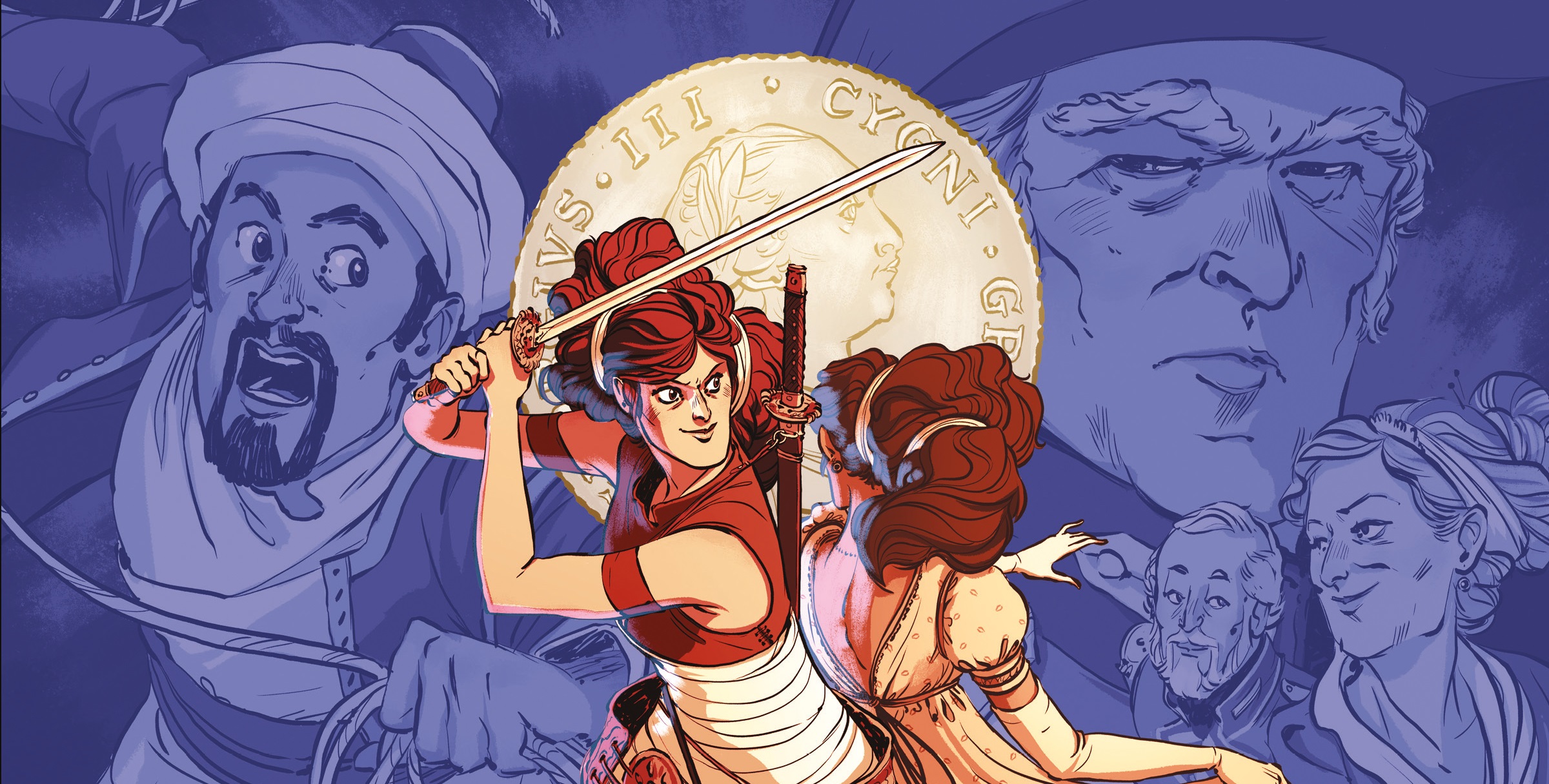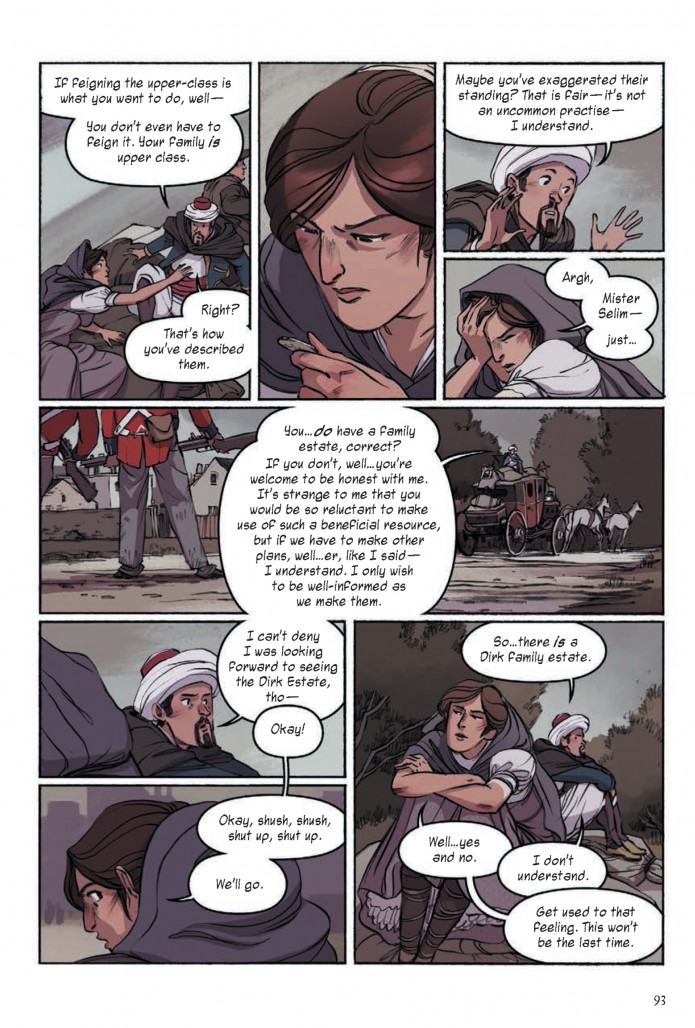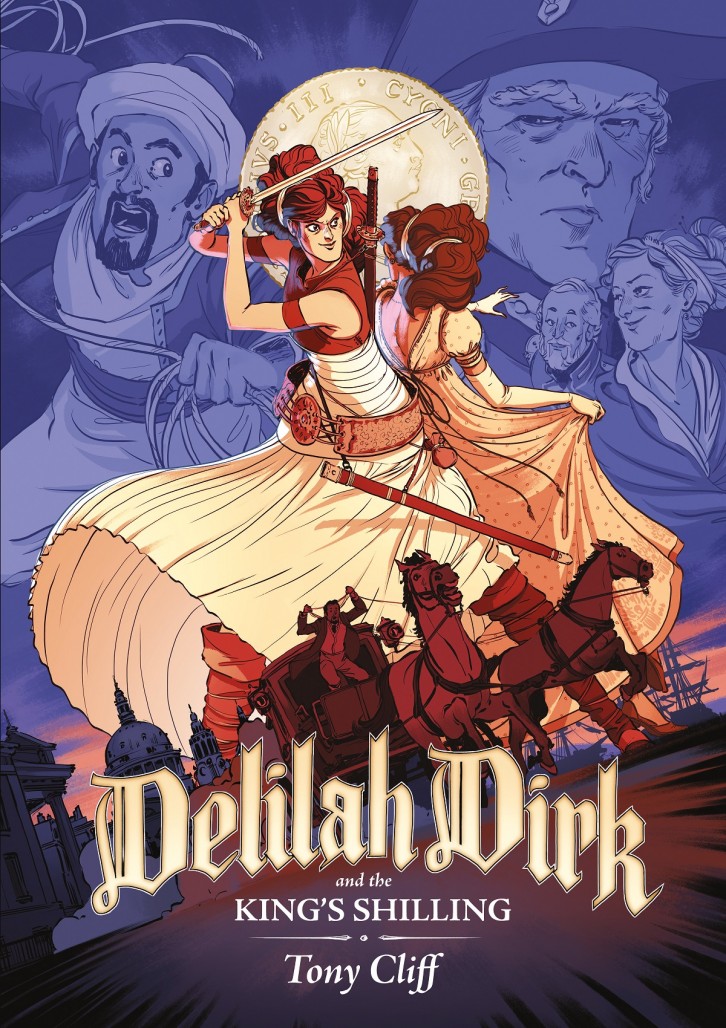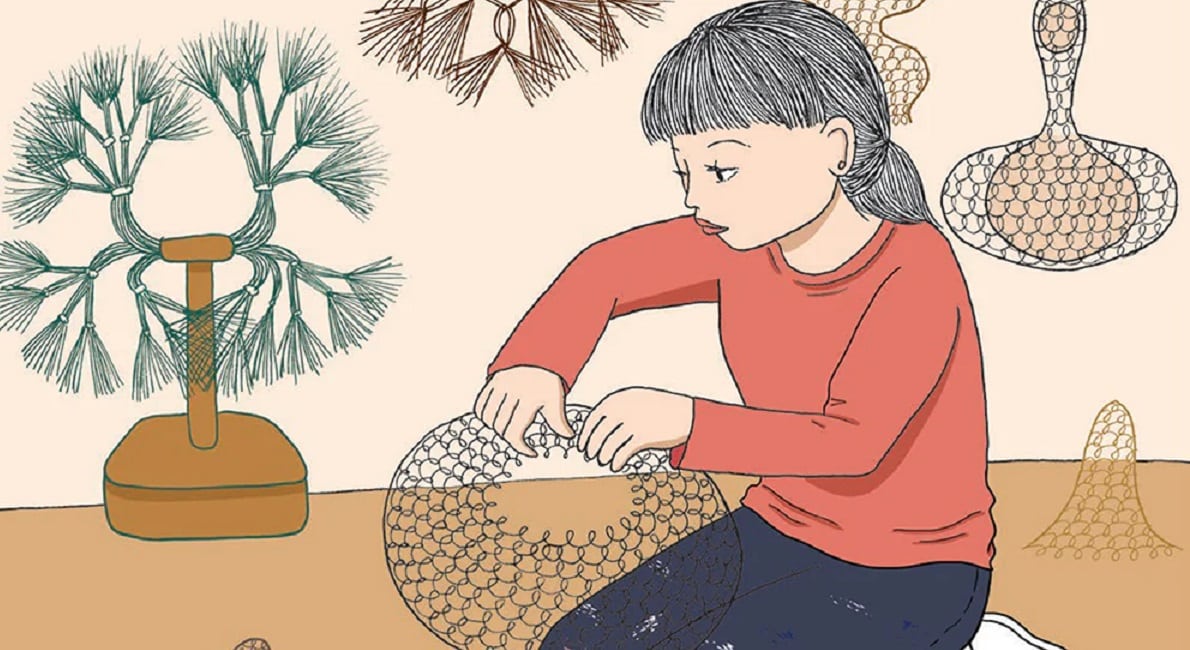In 2013, cartoonist Tony Cliff‘s Delilah Dirk and the Turkish Lieutenant, a historically-influenced adventure graphic novel, debuted to critical acclaim. Today, Delilah bursts back onto the scene with the release of Delilah Dirk and the King’s Shilling. While the first entry in the series saw Delilah take on an evil sultan in the Middle East, her latest adventure forces her to confront her past in order to protect England’s future.
As both artist and writer, Cliff has rendered his world with dynamic lines, beautiful colors, and well-shaded characters. Recently, I had a chance to speak to Cliff about the sources that influenced him while creating The King’s Shilling, how things have changed between the publication of The Turkish Lieutenant and now, and the all-too rare nature of the friendship between Delilah and her travelling companion, Selim.

Tony Cliff: Oh man, honestly, the hard part is getting them to stay the same; getting them to feel consistent from one book to another. I don’t feel like my perceptions figure into it: if I think about approaching the writing of Book Two, there’s the way the character’s already been established, and there’s what I want to do with the character in the new story. The tough part is balancing those elements so that you can go new places without the characters turning into other characters (otherwise, just make different characters, right?).
There was a point early on in the process of making The King’s Shilling (or DD2, as I like to call it) where Delilah’s interaction with her uncle wasn’t working quite right – she was letting her agency get taken away in a fashion that didn’t suit her character. I could tell something was wrong with it, but I couldn’t quite articulate what it was.
Fortunately, editors! Calista Brill, my editor at First Second on both DD1 and DD2, felt similarly about this sequence and was able to identify and verbalize the problem. As soon as she said it, the problem became a lot easier to see clearly and we spitballed a few solutions, one of which is in DD2 now. Now the relationship between DD and her uncle respects her agency while also allowing some warm give-and-take between them.
For me, those are the problems – building on the characters without taking away from them or making them feel “untrue.”
Lu: Given that you are the artist as well as the writer behind Delilah Dirk, has the way you rendered your characters changed as they have grown? Has your artistic style grown alongside them in some way?
Cliff: Ha ha ha, it’s been so long since I did the first DD pages that it would be almost impossible for things not to have changed. I look back at some of those early pages now and they feel to me the way First-Gen Garfield looks compared to even a couple books later. (What’s true for iPhones is true for Garfield: early adopters never get the most refined version). That’s why I’m so glad DD2 is finally out – the first book is (to my eyes) wildly inconsistent, having been built out of discrete short stories where I was still figuring out a lot about how to draw these characters, so I’m glad to have something published that represents a much more consistent look. It’s basically the grown-up version of, “hey, hey, look what I can do!” Everyone’s still got my old cartwheels on their shelves but guys I’ve been working on new cartwheels, I really want to show them to you.
There are two intentional changes I’m proud of: embracing the rough quality of pencil line art and using a “colour script.” In DD1, I was using clean pencil lines to simulate “inked” lines. For DD2, I figured, hey, if I’m using pencil, why not be honest about it and let the pencil do what it does naturally. I think the result feels better, maybe a little more genuine.
The colour script involved taking select panels, defining more limited colour palettes for them, and using those panels as colour reference for the rest of that sequence. DD1 was a bit rainbow-Technicolor. Reining in and being a little more selective, more controlled, and more intentional about those colour choices is a thing of which I’m proud.
Lu: Delilah and Selim’s relationship is noteworthy for its emotional depth and complexity. Oftentimes male and female leads in adventure stories are immediately paired off into romantic couples or have a tense and flirtatious dynamic. While some characters allude to the possibility of romance between Delilah and Selim, interactions between the two of them are remarkably platonic; caring in an almost familial way. What drove you to move their relationship in this direction rather than down the path well-trodden?
Cliff: Please don’t take offence, but this question basically answers itself, don’t you think? If so many stories go to that romantic place, why would we need another? The reason those characters allude to romance between DD and Selim is because A) realistically, a romantic association would be safe to assume given the time and place – genders did not typically mix; that’s where all the conflict in Austen novels comes from, isn’t it? And because B) I guess it turns out that romance is what most readers expect from opposite-sex characters? That all roads lead to bone-town?
I think we need more examples of men and women who can function as platonic friends. It happens in real life: I have first-hand evidence that men and women can, in fact, be friends, even though the current tenor of Internet discussion would have us believe otherwise. It’s gross that there are kids growing up who think they can only be friends with other humans of their same gender; that the opposite sex is only suitable for romantic interaction (I guess I’m just talking to the cis-hetero crowd here, feel free to run your own gender/pronoun substitutions as appropriate). That feels like such a bummer to me. Dudes: your life can be so much more rich if you allow yourself to have an earnest platonic relationship with a lady. And vice-versa. This seems so plainly obvious to me that I have a hard time believing some of the characterizations I see or read about. And starting out with DD, I never thought it was a big deal that DD and Selim became intertwined as friends – I just thought, “hey, why not?” Because: hey! Why not?
But this all gets into the area of me telling you what their relationship is intended to be, and I don’t like that. It is what it is on the page, and I’d prefer to leave it at that, and to hear you describe their repoire as “familial” feels nice. I’d love to introduce romantic themes to the characters at some point, but there are a lot of possibilities there. It’ll be an exciting thing to work out.
Lu: Were there people in your life who inspired the character of Delilah? Of Selim?
Cliff: My wife will routinely tell you that she inspired DD. She is not wrong. In some ways. Maybe.
Both DD and Selim are a mix of inspirations, some real, some fictional. Delilah borrows from Indiana Jones, Selim borrows from Horatio Hornblower, among others. Both are, in many ways, personal aspirations – I would like to aspire to DD’s adventurous enthusiasm and I enjoy trying on for size Selim’s tenacious adherence to his principles. They also get my weaknesses, too – DD’s stubborn and lies, Selim can be up his own butt with his language. Maybe the whole book is what kids these days would call a Gratuitous Picture of Yourself.
Lu: While there are hints of the fantastic throughout The King’s Shilling, for the most part, the events of the book are grounded in realism and steeped in history. What do you think those fantastic touches, such as Delilah imagining herself on a giant stag, or her flying ship, add to the work?
Cliff: Oh, that flying boat is just a convenience. Early on, I figured if DD was going to be a real, honest-to-goodness globe-trotting adventurer that she would need a way to get around quickly – more quickly than would ordinarily be possible. If it adds anything, I’d hope it would be an element of wonder, maybe a touch of tangible magic. Enough to just goose reality a little bit. The big suit-of-armour shoulder piece on Merrick’s sergeant is part of that. Not particularly realistic, but enough of an exaggeration to feel special. Or maybe I use these fantastical elements to distract from the ludicrous possibility that a man and woman could exist as friends (heh, sorry, this sounds like I’m taking the piss out of you, but what I meant was to chastise the hypothetical imagined person who thinks that idea is crazy).
Lu: As I came to the end of The King’s Shilling, I was astounded to read about the amount of historical research you had put into the graphic novel. In learning and reading about the French Revolution for this book, were there any lesser-known stories from the period that stood out to you? Did any of those stories make it into yours?
Cliff: The bulk of the research that I find myself needing/doing is really banal, everyday type things. The sort of thing that, if you were alive in the early 1800s would be common knowledge but that is now harder to find out. They’re foundational things – you don’t really see them in many cases, but they need to be there for the fiction to stand up. Things like, how fast do carriages travel? Which carriages would certain people have (like, is Delilah’s mother wealthy enough to own the carriage that I need for the story)? How many people are required to operate a carriage? What are the roads like? Do you necessarily have to change the horses? How long and how many horses would it require to get from one town to another? What do you do with the horses when they’re not pulling a carriage? And so on and so forth.
Because those details are so irrelevant to Important History Things, no one bothers to record them. But without them the whole thing would feel generic – like a Jane Austen skin stretched over just any old story. Of course, not every detail is necessary to the story – often, they can end up being world-building distractions. But you don’t discover that until you miss an important piece of research that you never knew you needed. Like the teacups in the early parts of The Turkish Lieutenant. They’re wrong. And, ordinarily, that wouldn’t be a dealbreaker, but tea plays a not-insignificant role in that book. Maybe the story arc isn’t crippled by the detail, but if you’re someone who can identify the error (and I’m sure many Turks are), that’s a gaffe that can ruin the cohesiveness of the setting and the sense of immersion, like when you clip through a wall in a video game.
Lu: Clearly, as The King’s Shilling shows, Delilah is a very heavily layered character with a complex past and a variety of goals in her life. However, what do you think the core of Delilah’s character is? What does she want most out of the world?
Cliff: That’s definitely a thing I have to leave on the page, I can’t speak to any of that. It’s a lose-lose proposition.
If you read the books and the core of her character comes across to you as X, and then I were to say “I intended her character to come across as Y,” then all outcomes are bad: either I am – at best – a clumsy writer incapable of translating intention to effect, or I imply that you did not interpret the material on the page “correctly.” No, whatever impression you have of Delilah, that is the correct impression. How gross would it be if the true nature of a character had to be discerned from somewhere other than the original material? (Unless that’s the intention, of course. That might be interesting.) So I will say that: I intend for Delilah to exist as you experience her character on the page. Whatever you believe to be her core, that is her core.
That goes for her wants, too. I think, true to any character real or fictional, that what she wants is entirely subject to change. And more importantly (and this all applies to Selim, too), what she thinks she wants, what she actually wants deep in her heart, and what she really needs are all changeable and difficult to always know with certainty. That opens her (and Selim) up to the possibility of discovering the truth of those things, and I think that’s where real satisfaction, happiness, and growth happens.
Delilah Dirk and the King’s Shilling is out now!









